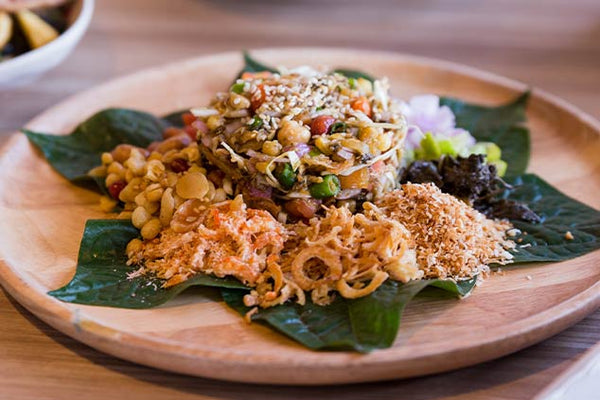The Ultimate Guide To Burmese Salads With The Rangoon Sisters

What are the different styles of salad eaten across Burma?
Burmese cuisine focuses on sweet, sour, salty and spicy flavours. Rice and noodles are key components to many of the dishes, most of which are garnished with the likes of chilli, lime and herbs to add extra flavours and textures, depending on personal preference.
Fruit and vegetables are celebrated in salads, with the most recognisable Burmese dish being the lahpet thoke (tea leaf salad). There are variations of a thoke (salads) throughout the country, influenced by what is locally available.
What brings them together is usually the focus on one ingredient. For example,
- aubergine in khayan thee thoke,
- chickpea tofu in tohu thoke, or
- noodles in khauk swe thoke.
What are the must-have ingredients for making Burmese salads?
We always have a supply of condiments in our kitchens for whipping up a Burmese salad. These would include:
- Homemade flavoured oils such as garlic and shallot, which are easy to make and keep well in air-tight jars
- Toasted gram flour which adds a slight nuttiness and texture
- Fish sauce
- Dried shrimps in the fridge
- Fresh lime
- Shrimp paste
- Dried shrimp powder
- Chilli
- Tamarind
- Crunchy peanuts
Then as mentioned above, you could use most vegetables you might have at home or rice, noodles, potato which most people will already have in their cupboards. Feel free to experiment!
The ingredients are traditionally mixed by hand to fully intersperse the ingredients (but using cutlery is fine too!).
What are the key flavours and textures in a Burmese salad?
Salt is the key flavour - from umami-rich fish sauce, dried shrimp and shrimp paste (soy can be a substitute if you are vegetarian). This is balanced against sour, sweet and chilli heat.
Texture is really important in Burmese cuisine and in salads this may come from:
- fresh crisp vegetables,
- soft noodles,
- crispy fried fritters,
- beans and
- nuts.
When are salads typically eaten in Burmese cuisine?
A typical Burmese meal involves eating different dishes all shared together, so you would have salads alongside curries, pickles, soup, rice and vegetables.
However, both of us would also happily eat a salad on its own. We often make our own Burmese-style fridge forage salads using bits and bobs that we have leftover.
What makes a Burmese salad unique?
Burmese salads are unique in the way they balance the four key flavours. They’re verstalise in the sense that you can personalise them depending on what you like, increasing the heat, sharpness or sweetness.
Instead of being a side, salads are often a main event. While Burmese salads can be made with just vegetables, it is often the case that a salad is made out of many elements - a leftover Sunday roast chicken in kyet thar thoke (spiced chicken salad) is a popular choice.
What is a tea leaf (lahpet) salad and how is one made?

Lahpet thoke (tea leaf salad) is made with fermented tea leaves. It is a dish unique to Burma where it is thought to be the only place in the world where tea is eaten rather than just enjoyed as a drink!
The tea leaves are slightly acidic, but when combined with freshly shredded cabbage, sliced tomatoes, dried shrimp powder, lime juice, chilli, garlic oil and crispy beans and nuts, lahpet thoke is a flavour bomb.
We think it’s a really special salad, moreish and really popular at our supper clubs. People love it, and it also gives you that caffeine hit at the end of the meal!







